Owl
| Owl Fossil range: Late Paleocene–Recent |
|
|---|---|
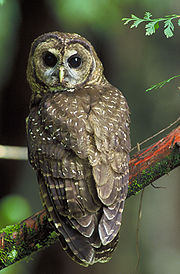 |
|
| The rare Northern Spotted Owl Strix occidentalis caurina |
|
| Scientific classification | |
| Kingdom: | Animalia |
| Phylum: | Chordata |
| Class: | Aves |
| Subclass: | Neornithes |
| Infraclass: | Neognathae |
| Superorder: | Neoaves |
| Order: | Strigiformes Wagler, 1830 |
| Families | |
|
Strigidae |
|
| Synonyms | |
|
Strigidae sensu Sibley & Ahlquist |
|
Owls are the order Strigiformes, comprising 200 extant bird of prey species. Most are solitary and nocturnal with some exceptions (e.g. the Northern Hawk Owl). Owls hunt mostly small mammals, insects, and other birds though a few species specialize in hunting fish. They are found in all regions of the Earth except Antarctica, most of Greenland and some remote islands. Though owls are typically solitary, the literary collective noun for a group of owls is a parliament.
Living owls are divided into two families: the typical owls, Strigidae; and the barn-owls, Tytonidae.
Contents |
Description
Owls have large forward-facing eyes and ear-holes, a hawk-like beak, a flat face, and usually a conspicuous circle of feathers, a facial disc, around each eye. Most birds of prey sport eyes on the sides of their heads, but the stereoscopic nature of the owl's forward-facing eyes permits a greater sense of depth perception necessary for low-light hunting. Although owls have binocular vision, their large eyes are fixed in their sockets, as with other birds, and they must turn their entire head to change views. Owls can rotate their heads and necks as much as 270 degrees in either direction.[1][2][3] Owls are farsighted and are unable to see anything clearly within a few centimeters of their eyes. Caught prey can be felt by owls with the use of filoplumes, which are small hair-like feathers on the beak and feet that act as "feelers". Their far vision, particularly in low light, is exceptionally good.
The smallest owl is the Elf Owl (Micrathene whitneyi), at as little as 31 g (1.1 oz) and 13.5 cm (5.3 inches). Some of the pygmy owls are scarcely larger. The largest owls are two of the eagle owls; the Eurasian Eagle Owl (Bubo bubo) and Blakiston's Fish Owl (Bubo blakistoni)—which may reach a size of 60 – 71 cm (28.4 in) long, have a wingspan of almost 2 m (6.6 ft), and an average weight of nearly 4.5 kg (10 lb).
Different species of owls make different sounds; the wide range of calls aids owls in finding mates or announcing their presence to potential competitors, and also aids ornithologists and birders in locating these birds and recognizing species. The facial disc helps to funnel the sound of prey to their ears. In many species, these are placed asymmetrically, for better directional location.[4]
The plumage of owls is generally cryptic, but many species have facial and head markings, including face masks, ear tufts and brightly coloured irises. These markings are generally more common in species inhabiting open habitats, and are thought to be used in signalling with other owls in low light conditions.[5]
Owl eggs usually have a white colour and almost spherical shape, and range in number from a few to a dozen, depending on species. Eggs are laid at intervals of 1 to 3 days and do not hatch at the same time. This accounts for the wide variation in the size of sibling nestlings. Owls do not construct nests, but rather look for a sheltered nesting site or an abandoned nest in trees, underground burrows, or in buildings, barns and caves.
Behaviour
Most owls are nocturnal, actively hunting for prey only under the cover of darkness. Several types of owl, however, are crepuscular, active during the twilight hours of dawn and dusk; one example is the pygmy owl (Glaucidium). A few owls are also active during the day; examples are the Burrowing Owl (Speotyto cunicularia) and the Short-eared Owl (Asio flammeus).
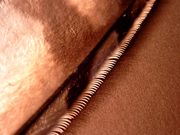
Much of the owls' hunting strategy depends on stealth and surprise. Owls have at least two adaptations that aid them in achieving stealth. First, the dull coloration of owls' feathers can render them almost invisible under certain conditions. Secondly, serrated edges on the leading edge owls' remiges muffle an owl's wing beats, allowing its flight to be practically silent. Some fish-eating owls, for which silence is of no evolutionary advantage, lack this adaptation.
An owl's sharp beak and powerful talons allow it to kill its prey before swallowing it whole (unless it is too big). Scientists studying the diets of owls are helped by their habit of regurgitating the indigestible parts of their prey (such as bones, scales and fur) in the form of pellets. These "owl pellets", which are plentiful and easy to interpret, are often sold by companies to schools for dissection by students as a lesson in biology and ecology.[6]
Evolution and systematics

The systematic placement of owls is disputed. For example, the Sibley-Ahlquist taxonomy finds that, based on DNA-DNA hybridization, owls are more closely related to the nightjars and their allies (Caprimulgiformes) than to the diurnal predators in the order Falconiformes; consequently, the Caprimulgiformes are placed in the Strigiformes, and the owls in general become a family Strigidae. A recent study indicates that the drastic rearrangement of the genome of the accipitrids may have obscured any close relationship of theirs with groups such as the owls .[7] In any case, the relationships of the Caprimulgiformes, the owls, the falcons and the accipitrid raptors are not resolved to satisfaction; currently there is an increasing trend to consider each group (with the possible exception of the accipitrids) a distinct order.
There are some 220 to 225 extant species of owls, subdivided into two families: typical owls (Strigidae) and barn-owls (Tytonidae). Some entirely extinct families have also been erected based on fossil remains; these differ much from modern owls in being less specialized or specialized in a very different way (such as the terrestrial Sophiornithidae). The Paleocene genera Berruornis and Ogygoptynx show that owls were already present as a distinct lineage some 60 - 57 mya (million years ago), and, hence, possibly also some 5 million years earlier, at the extinction of the non-avian dinosaurs. This makes them one of the oldest known groups of non-Galloanserae landbirds. The supposed "Cretaceous owls" Bradycneme and Heptasteornis are apparently non-avialan maniraptors.[8]
During the Paleogene, the Strigiformes radiated into ecological niches now mostly filled by other groups of birds. The owls as we know them today, on the other hand, evolved their characteristic morphology and adaptations during that time, too. By the early Neogene, the other lineages had been displaced by other bird orders, leaving only barn-owls and typical owls. The latter at that time were usually a fairly generic type of (probably earless) owl similar to today's North American Spotted Owl or the European Tawny Owl; the diversity in size and ecology found in typical owls today developed only subsequently.
Around the Paleogene-Neogene boundary (some 25 mya), barn-owls were the dominant group of owls in southern Europe and adjacent Asia at least; the distribution of fossil and present-day owl lineages indicates that their decline is contemporary with the evolution of the different major lineages of typical owls, which for the most part seems to have taken place in Eurasia. In the Americas, there was rather an expansion of immigrant lineages of ancestral typical owls.
The supposed fossil herons "Ardea" perplexa (Middle Miocene of Sansan, France) and "Ardea" lignitum (Late Pliocene of Germany) were more probably owls; the latter was apparently close to the modern genus Bubo. Judging from this, the Late Miocene remains from France described as "Ardea" aureliensis should also be restudied.[9] The Messelasturidae, some of which were initially believed to be basal Strigiformes, are now generally accepted to be diurnal birds of prey showing some convergent evolution towards owls. The taxa often united under Strigogyps[10] were formerly placed in part with the owls, specifically the Sophiornithidae; they appear to be Ameghinornithidae instead.[11]
For fossil species and paleosubspecies of extant taxa, see the genus and species articles.
Unresolved and basal forms (all fossil)
- Berruornis (Late Paleocene of France) - basal? Sophornithidae?
- Strigiformes gen. et ap. indet. (Late Paleocene of Zhylga, Kazakhstan)
- Palaeoglaux (Middle – Late Eocene of WC Europe) - own family Palaeoglaucidae or Strigidae?
- Palaeobyas (Late Eocene/Early Oligocene of Quercy, France) - Tytonidae? Sophiornithidae?
- Palaeotyto (Late Eocene/Early Oligocene of Quercy, France) - Tytonidae? Sophiornithidae?
- Strigiformes gen. et spp. indet. (Early Oligocene of Wyoming, USA)[12]
Ogygoptyngidae
- Ogygoptynx (Middle/Late Paleocene of Colorado, USA)
Protostrigidae
- Eostrix (Early Eocene of WC USA and England - Middle Eocene of WC USA)
- Minerva (Middle – Late Eocene of W USA) - formerly Protostrix, includes "Aquila" ferox, "Aquila" lydekkeri, and "Bubo" leptosteus
- Oligostrix (mid-Oligocene of Saxony, Germany)
Sophiornithidae
- Sophiornis
Strigidae: Typical owls

- Aegolius: saw-whet owls, four species
- Asio: eared owls, 6–7 species
- Athene: 2–4 species (depending on whether Speotyto and Heteroglaux are included or not)
- Bubo: horned owls, eagle-owls and fish-owls; paraphyletic with Nyctea, Ketupa and Scotopelia, some 25 species
- Ciccaba: four species
- Glaucidium: pygmy-owls, about 30–35 species
- Gymnoglaux: Bare-legged Owl or Cuban Screech-owl
- Jubula: Maned Owl
- Lophostrix: Crested Owl
- Megascops: screech-owls, some 20 species
- Micrathene: Elf Owl
- Mimizuku: Giant Scops-owl or Mindanao Eagle-owl
- Ninox: Australasian hawk-owls, some 20 species
- Nesasio - Fearful Owl
- Otus: scops-owls; probably paraphyletic, about 45 species
- Pseudoscops: Jamaican Owl and possibly Striped Owl
- Ptilopsis: white-faced owls, two species
- Pulsatrix: spectacled owls, three species
- Pyrroglaux: Palau Owl
- Strix: earless owls, about 15 species
- Surnia: Northern Hawk-owl
- Uroglaux: Papuan Hawk-owl
- Xenoglaux: Long-whiskered Owlet
- Mascarenotus: Mascarene owls, three species; extinct (c.1850)
- Sceloglaux: Laughing Owl; extinct (1914?)
- Grallistrix: stilt-owls, four species; prehistoric
- Ornimegalonyx: Caribbean giant owls, 1–2 species; prehistoric
Fossil genera
- Mioglaux (Late Oligocene? - Early Miocene of WC Europe) - includes "Bubo" poirreiri
- "Otus/Strix" wintershofensis: fossil (Early/Middle Miocene of Wintershof West, Germany) - may be close to extant genus Ninox[12]
- Intutula (Early/Middle –? Late Miocene of C Europe) - includes "Strix/Ninox" brevis
- Alasio (Middle Miocene of Vieux-Collonges, France) - includes "Strix" collongensis
Placement unresolved
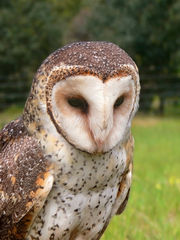
- "Strix" edwardsi: fossil (Middle Miocene)
- "Asio" pygmaeus: fossil (Early Pliocene of Odessa, Ukraine)
- Ibiza Owl, Strigidae gen. et sp. indet.: prehistoric[13]
Tytonidae: Barn-owls
- Genus Tyto: typical barn-owls, stand up to 1⁄2 feet (0.15 m) tall. Some 15 species and possibly one recently extinct
- Genus Phodilus: bay-owls, 1–2 extant species and possibly one recently extinct
Fossil genera
- Nocturnavis (Late Eocene/Early Oligocene) - includes "Bubo" incertus
- Necrobyas (Late Eocene/Early Oligocene - Late Miocene) - includes "Bubo" arvernensis and Paratyto
- Selenornis (Late Eocene/Early Oligocene) - includes "Asio" henrici
- Prosybris (Early Oligocene? - Early Miocene)
Placement unresolved
- Tytonidae gen. et sp. indet. "TMT 164" (Middle Miocene) - Prosybris?
Relationship with humans
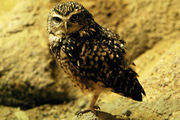
Africa
Among the Kikuyu of Kenya it was believed that owls were harbingers of death. If one saw an owl or heard its hoot, someone was going to die. In general, owls are viewed as harbingers of bad luck, ill health, or death. The belief is widespread even today.[14]
The Americas
In the culture of the Uto-Aztec tribe, the Hopi, taboos surround owls, which are associated with sorcery and other evils. The Aztecs and Maya, along with other Natives of Mesoamerica, considered the owl a symbol of death and destruction. In fact, the Aztec god of death, Mictlantecuhtli, was often depicted with owls. There is an old saying in Mexico that is still in use[15]: Cuando el tecolote canta, el indio muere ("When the owl cries/sings, the Indian dies"). The Popol Vuh, a Mayan religious text, describes owls as messengers of Xibalba (the Mayan "Place of Fright").[16] The belief that owls are messengers and harbingers of the dark powers is also found among the Hočągara (Winnebago) of Wisconsin.[17] When in earlier days the Hočągara committed the sin of killing enemies while they were within the sanctuary of the chief's lodge, an owl appeared and spoke to them in the voice of a human, saying, "From now on the Hočągara will have no luck." This marked the beginning of the decline of their tribe.[18] An owl appeared to Glory of the Morning, the only female chief of the Hočąk nation, and uttered her name. Soon afterwards she died.[19] People often allude to the reputation of owls as bearers of supernatural danger when they tell misbehaving children, "the owls will get you." [20]
Western culture
The modern West generally associates owls with wisdom. This link goes back at least as far as Ancient Greece, where Athens, noted for art and scholarship, and Athena, Athens' patron goddess and the goddess of wisdom, had the owl as a symbol.[21] Marija Gimbutas traces veneration of the owl as a goddess, among other birds, to the culture of Old Europe, long pre-dating intrusive Indo-European cultures.[22]
Owls were considered funerary birds among the Romans.
Use as rodent control
Encouraging natural predators to control rodent population is a natural form of pest control, along with excluding food sources for rodents. Placing a new box for owls on a property can help control rodent populations (one family of hungry barn owls can consume more than 3,000 rodents in a nesting season) while maintaining the naturally balanced food chain.[23]
Owl conservation issues
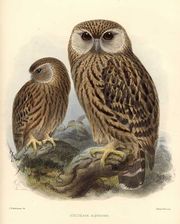
All owls are listed in Appendix II of the international CITES treaty (the Convention on Illegal Trade in Endangered Species of Wild Fauna and Flora). Although owls have long been hunted, a 2008 news story from Malaysia indicates that the magnitude of owl poaching may be on the rise. In November 2008, TRAFFIC reported the seizure of 900 plucked and "oven-ready" owls in Peninsular Malaysia. Said Chris Shepherd, Senior Programme Officer for TRAFFIC's Southeast Asia office, "This is the first time we know of where 'ready-prepared' owls have been seized in Malaysia, and it may mark the start of a new trend in wild meat from the region. We will be monitoring developments closely." Traffic commended the Department of Wildlife and National Parks in Malaysia for the raid that exposed the huge haul of owls. Included in the seizure were dead and plucked Barn Owls, Spotted Wood Owls, Crested Serpent Eagles, Barred Eagles, and Brown Wood Owls, as well as 7,000 live lizards.[24]
Footnotes
- ↑ "San Diego Zoo Birds: Owl". San Diego Zoo. http://www.sandiegozoo.org/animalbytes/t-owl.html. Retrieved 2010-08-24.
- ↑ "A Parliament of Owls". Colorado Division of Wildlife. http://wildlife.state.co.us/Education/TeacherResources/ColoradoWildlifeCompany/OwlsCWCWin9293.htm. Retrieved 2010-8-24.
- ↑ "The Owls of Big Bend". National Park Service U.S. Department of the Interior. http://www.nps.gov/bibe/naturescience/owls.htm. Retrieved 2010-08-24.
- ↑ Cotty, 2008.
- ↑ Galeotti, Paolo; Diego Rubolini (2007). "Head ornaments in owls: what are their functions?". Journal of Avian Biology 38 (6): 731–736. doi:10.1111/j.0908-8857.2007.04143.x.
- ↑ "Owl Pellets in the Classroom: Safety Guidelines".
- ↑ See Haaramo (2006). In reality, the presumed distant relationship of the accipitrids - namely, the "Accipitriformes" according to Sibley and Ahlquist (1990) - with owls (and most other bird lineages) is most likely due to systematic error. Accipitrids have undergone drastic chromosome rearrangement and thus appear in DNA-DNA hybridization generally unlike other living birds.
- ↑ Mortimer (2004)
- ↑ Olson (1985): pp.131, 267
- ↑ Mayr (2005)
- ↑ Alvarenga & Höfling (2003), Peters (2007)
- ↑ 12.0 12.1 Olson 1985: p.131
- ↑ Sánchez Marco (2004)
- ↑ "Owls in Lore and Culture - The Owl Pages". Owlpages.com. http://www.owlpages.com/articles.php?section=Owl+Mythology&title=Owls+Lore+Culture&page=8. Retrieved 2009-07-29.
- ↑ "La Cronica". http://www.cronica.com.mx/especial.php?id_tema=1010&id_nota=375192. Retrieved 2009-03-21.
- ↑ "The Popol Vuh". http://www.meta-religion.com/World_Religions/Ancient_religions/Central_america/popol_vuh.htm. Retrieved 2008-07-23.
- ↑ See the article "Owls" in the Hočąk Encyclopedia. Retrieved: 4/21/09.
- ↑ Paul Radin, The Winnebago Tribe (Lincoln: University of Nebraska Press, 1990 [1923]) 7-9.
- ↑ David Lee Smith, Folklore of the Winnebago Tribe (Norman: University of Oklahoma Press, 1997) 160. See also "Glory of the Morning" in the Hočąk Encyclopedia. Retrieved: 4/21/09.
- ↑ E. W. Lenders, "The Myth of the 'Wah-ru-hap-ah-rah,' or the Sacred Warclub Bundle," Zeitschrift für Ethnologie 46 (1914): 404-420, p. 409.
- ↑ Deacy, Susan, and Alexandra Villing. Athena in the Classical World. 1st ed. Koninklijke Brill NV,Leiden, The Netherlands: Brill, 2001. Print.
- ↑ The living goddesses, Marija Gimbutas, University of California Press, 2001, p 158.
- ↑ "The Hungry Owl Project". Hungryowl.org. http://www.hungryowl.org/. Retrieved 2009-07-29.
- ↑ Wednesday (2008-11-12). "Wildlife Trade News - Huge haul of dead owls and live lizards in Peninsular Malaysia". Traffic. http://www.traffic.org/home/2008/11/12/huge-haul-of-dead-owls-and-live-lizards-in-peninsular-malays.html. Retrieved 2009-07-29.
References
- Alvarenga, Herculano M. F. & Höfling, Elizabeth (2003): Systematic revision of the Phorusrhacidae (Aves: Ralliformes). Papéis Avulsos de Zoologia 43(4): 55-91 The Spirit of Ancient Peru:Treasures from the Museo Arqueológico Rafael Larco Herrera. Thames and Hudson, New York.
- Calaprice, Alice & Heinrich, Bernd (1990): Owl in the House: A Naturalist's Diary. Joy Street Books, Boston. ISBN 0316354562
- Haaramo, Mikko (2006): Mikko's Phylogeny Archive: "Caprimulgiformes" - Nightjars. Version of May 11, 2006. Retrieved November 8, 2007.
- Heinrich, Bernd (1987): One Man's Owl
- Johnsgard, Paul A. (2002): North American Owls: Biology and Natural History, 2nd ed.. Smithsonian Institution Press, Washington DC. ISBN 1-56098-939-4
- Mayr, Gerald (2005): "Old World phorusrhacids" (Aves, Phorusrhacidae): a new look at Strigogyps ("Aenigmavis") sapea (Peters 1987). PaleoBios (Berkeley) 25(1): 11-16 HTML abstract
- Mortimer, Michael (2004): The Theropod Database: Phylogeny of taxa. Retrieved August 14, 2008.
- Norberg, R.A. (1977): Occurrence and independent evolution of bilateral ear asymmetry in owls and implications on owl taxonomy. Philosophical Transactions of the Royal Society of London, Series B, Biological Sciences 280: 375-408.
- Olson, Storrs L. (1985): The fossil record of birds. In: Farner, D.S.; King, J.R. & Parkes, Kenneth C. (eds.): Avian Biology 8: 79-238. Academic Press, New York.
- Peters, Dieter Stefan (2007): The fossil family Ameghinornithidae (Mourer-Chauviré 1981): a short synopsis. Journal of Ornithology 148(1): 25-28. doi:10.1007/s10336-006-0095-z PDF fulltext
- Sánchez Marco, Antonio (2004): Avian zoogeographical patterns during the Quaternary in the Mediterranean region and paleoclimatic interpretation. Ardeola 51(1): 91-132. PDF fulltext
- Sibley, Charles Gald & Monroe, Burt L. Jr. (1990): Distribution and taxonomy of the birds of the world: A Study in Molecular Evolution. Yale University Press, New Haven, CT. ISBN 0-300-04969-2
External links
- The Owl Pages
- Animal Diversity Web Page: Owls
- Owl Brain Atlas
- Smithsonian Snowy Owl Info
- Owls of the Harry Potter movies - learn about the owls featured in the films, threats to the species, and conservation activities
- World Owl Trust
- Athenian Owl coins
- Owl videos on the Internet Bird Collection
Eurasia
- World of Owls - Northern Irelands only Owl, Bird of Prey and Exotic Animal Centre
- Current Blakiston's Fish Owl Research in Russia
North America